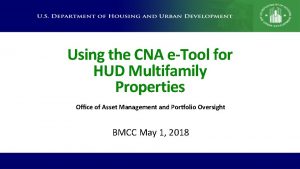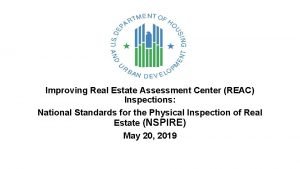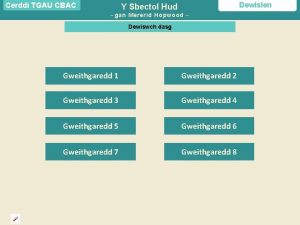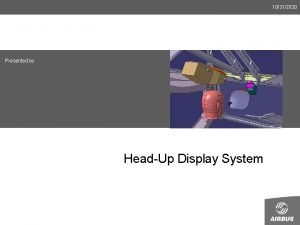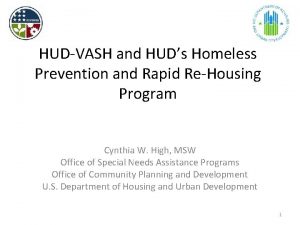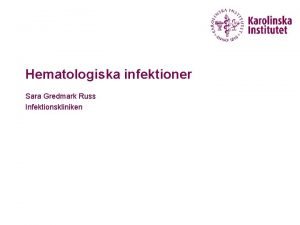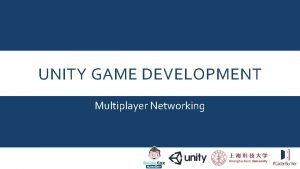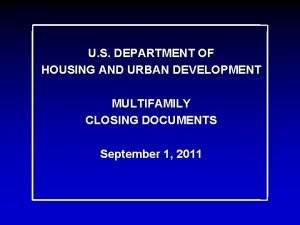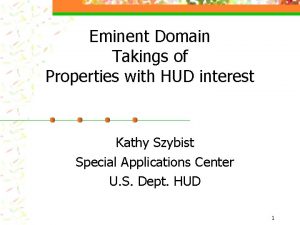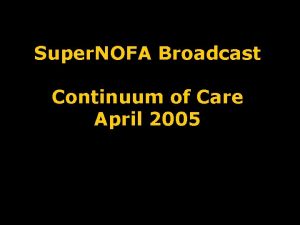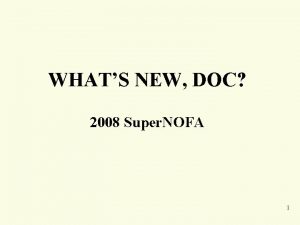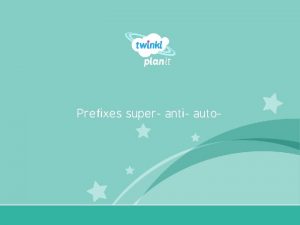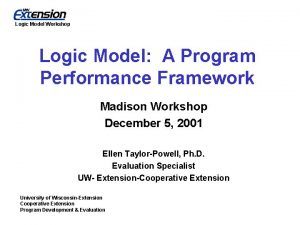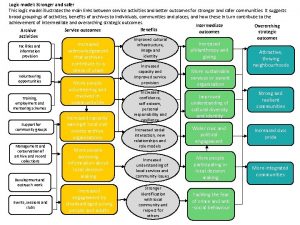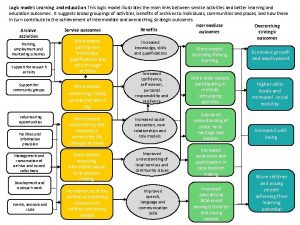Logic Model Training for HUD Super NOFA Grantees









































- Slides: 41

Logic Model Training for HUD Super. NOFA Grantees U. S. Department of Housing and Urban Development Satellite Broadcast – June 1, 2004 – 2: 00 PM-5: 00 PM Washington, DC The Center for Applied Management Practices, Inc. 3609 Gettysburg Road, Camp Hill, PA 17011 (717) 730 -3705 – info@appliedmanagement. org

Measurement and Accountability Congress passes the Government Performance and Results Act (GPRA) in 1993 establishing strategic planning and performance measurement in the Federal government and federally funded programs. • Establish performance goals to define the level of performance to be achieved by a program activity. • Express such goals in an objective, quantifiable, and measurable form.

Measurement and Accountability Congress passes the Government Performance and Results Act (GPRA) in 1993 establishing strategic planning and performance measurement in the Federal government and federally funded programs. • Establish performance indicators to be used in measuring or assessing the relevant outputs, service levels, and outcomes of each program activity. • Provide a basis for comparing the actual program results with the established performance goals. • Describe the means to be used to verify and validate measured values.

Measurement and Accountability Congress passes the Government Performance and Results Act (GPRA) in 1993 establishing strategic planning and performance measurement in the Federal government and federally funded programs. • Describe the means to be used to verify and validate measured values.

HUD’s Strategic Goals • Increase homeownership opportunities. • Promote decent affordable housing. • Strengthen communities. • Ensure equal opportunity in housing. • Embrace high standards of ethics, management, and accountability. • Promote participation of grass-roots faith-based and other communitybased organizations.

HUD’s Policy Priorities • • Providing increased homeownership and rental opportunities for low and moderate income persons, persons with disabilities, the elderly, minorities, and families with limited English proficiency. Improving our nation’s communities. Encouraging accessible design features. Providing full and equal access to grass-roots faith-based and other community-based organizations in HUD program implementation.

HUD’s Policy Priorities • • • Participation of minority serving institutions in HUD programs. Ending chronic homelessness in ten years. Removal of regulatory barriers to affordable housing.

Introduction to the Logic Model • The logic model is a tool that links public policy and program operations, with program accountability. • All Logic Models share common characteristics including identification of: the problem or need, the service or activity, and outcomes and measurement reporting tools.

Introduction to the Logic Model • The logic model is an abstract of the program or service that is under consideration for funding or has already been funded. The logic model is representative of the entire grant application and serves as the “ambassador” for the grant request. In this context it is used to make a “first impression. ”

Why Does HUD Use a Logic Model? Data from the HUD logic model can be used by grantees and HUD program staff to support management and monitoring activities including: • How grantees perform with regard to meeting projected outputs and outcomes. • The ability to monitor program activity while it is occurring rather than after the fact. • The ability to institute preventive corrective action to support on-going operations rather than a post evaluation remedy after the fact.

Why Does HUD Use a Logic Model? Data from the HUD logic model can be used by grantees and HUD program staff to support management and monitoring activities including: • The ability to identify successful programs and why they are successful. • The ability to replicate successful programs in other sites based on good information from existing programs.

HUD Logic Model

Logic Model. U. S. Department of Housing and Urban Development Office of Departmental Grants Management and Oversight OMB Approval No. 2535 -0114 (exp. 12/31//2006) Program Name: ______________________ Strate gic Goals Policy Priorit ies 1 Problem, Need, Situation Service or Activity 2 3 Policy HUD’s Strategic Goals: 1 -6 Planning Component Name: ______________________ Benchmarks Output Goal Output Result Achieve ment Outcome Goals End Results Measurement Reporting Tools 4 5 6 7 8 Intervention Outcomes Impact 9 Accountability Short Term a. b. c. d. e. Interme diate Term a. b. c. d. e. Long Term a. b. c. d. e. Policy Priorities: 1 -7 Evaluation Process

How To Complete the HUD Logic Model – P 1 • Column 1: HUD’s Strategic Goals. Indicate in this column the number of the goal(s) that your proposed service or activity is designed to achieve. Action – Column 1 – Strategic Goals – Policy: Identify which of the six HUD Strategic Goals are to be addressed in the logic model. You can identify more than one goal. Use the number(s) provided in the logic model.

How To Complete the HUD Logic Model – P 1 Policy Priority: Indicate in this column the number of the HUD Policy Priority(ies), if any, your proposed service or activity promotes. Applicants are encouraged to undertake specific activities that will assist the Department in implementing its Policy Priorities. Action – Column 1 – Policy Priorities – Policy: Identify which of the seven HUD Policy Priorities are to be addressed in the logic model. You can identify more than one priority. Use the number(s) provided in the logic model.

How To Complete the HUD Logic Model – P 2 • Column 2: Problem, Need, or Situation: Provide a general statement of need that provides the rationale for the proposed service or activity. • Column 3: Service or Activity: Identify the activities or services that you are undertaking in your work plan which are crucial to the success of your program. Not every activity or service yields a direct outcome.

How To Complete the HUD Logic Model – P 3 • Column 4 and Column 5: Benchmarks: These columns ask you to identify benchmarks that will be used in measuring the progress of your services or activities. Column 4: Benchmarks/Output Goal: Set quantifiable output goals, including timeframes. These should be products or interim products, which allow you and HUD to monitor and assess your progress in achieving your program workplan.

How To Complete the HUD Logic Model – P 3 Column 5: Benchmark/Output Result: Report actual result of your benchmarks. The actual result could be the number of housing units developed or rehabilitated, jobs created, or number of person assisted. Outputs may be short, intermediate, or long-term. (Do not fill out this section with the application).

How To Complete the HUD Logic Model – P 4 • Column 6 and Column 7: Outcomes: Report on your expected and actual outcomes-the ultimate impact you hope to achieve. Column 6: Outcomes/Goals: Identify the outcomes that resulted in broader impacts for individuals, families/households, and/or the community. For example, the program may seek to improve the environmental conditions in a neighborhood, increase affordable housing, increase the assets of a low-income family, or improve selfsufficiency.

How To Complete the HUD Logic Model – P 4 • Proxy Outcome(s): Often direct measurement of the intended outcome is difficult or even impossible—to measure. In these cases, applicants/grantees should use a proxy or surrogate measure that corresponds with the desired outcome. For example, improving quality of life in a neighborhood could be measured by a proxy outcome such as increases in home prices or decreases in crime. The person receiving the services must meet eligibility requirements of the program.

How To Complete the HUD Logic Model – P 4 Column 7: Outcomes/Actual Result: Identify specific achievements of outcomes listed in Column 6. (Do not fill out this section with the application).

How To Complete the HUD Logic Model – P 5 • Column 8: Measurement Reporting Tools: • List the tools used to track output or outcome information e. g. survey instrument; attendance log; case report; pre-post test; waiting list; etc. • Identify the place where data is maintained, e. g. central database; individual case records; specialized access database, tax assessor database; local precinct; other. • Identify the location, e. g. on-site; subcontractor; other.

How To Complete the HUD Logic Model – P 5 • Column 8: Measurement Reporting Tools: • Indicate how often data is required to be collected, who will collect it, and how often data is reported to HUD. • Describe methods for retrieving data, e. g. , data from case records is retrieved manually, data is maintained in an automated database. This tool will be available for HUD review and monitoring and should be used in submitting reporting information.

How To Complete the HUD Logic Model – P 5 • Column 9: Evaluation Process: Identify the methodology you will periodically use to assess your success in meeting your benchmark output goals and output results, outcomes associated to the achievement of the purposes of the program, as well as the impact that the work has made on the individuals assisted, the community, and the strategic goals of the Department.

Proxy Outcomes A proxy outcome is when the activity, service, or intervention is also the same as the outcome. Use of a proxy outcome must be justified and documented. A proxy outcome may be used when: • it is supported by previous research and the client is eligible for the service, • it is not practical to measure the actual program outcome, • it is not yet certain what the specific outcome is, • it is the best outcome available until better data collection procedures can be developed.

How To Write and Organize A Logic Model – P 1 Column 1 – Strategic Goals – Policy There are six HUD Strategic Goals. • Choose one or more Strategic Goals that relate to your grant application. • Select those Strategic Goals that best represent your program or service. Do not select all the Strategic Goals.

How To Write and Organize A Logic Model – P 2 Column 1 – Policy Goals – Policy There are seven HUD Policy Priorities. • Choose one or more Policy Priorities that relate to your grant application. • Select those Policy Priorities that best represent your program or service. Do not select all the Policy Priorities.

How To Write and Organize A Logic Model – P 3 • Column 2 – Problem, Need, Situation – Planning • Write a clear and concise statement that identifies the problem, need, or situation. • Ensure that the statement is consistent with the identified HUD Strategic Goal(s) and Policy Priority(ies). • If this statement is unclear, the rest of the logic model is at risk. Describing services, outputs, and outcomes without a clear and concise problem statement is not a supportable logic model.

How To Write and Organize A Logic Model – P 4 • • • Column 3 – Service or Activity – Planning Identify the services or activities that will be used to address the presenting problem, need, or situation. Ensure that the services or activities are appropriate for the identified problem, need, or situation identified in Column 2. Establish a realistic timeframe. Identify the number of people or number of services or activities offered.

How To Write and Organize A Logic Model – P 5 • • • Column 4 – Benchmarks – Output Goal – Intervention Identify quantifiable output goals, including timeframes. These should be products, or interim products, which allow you and HUD to monitor and assess your progress in achieving your program work plan. Ensure that the output(s) match the service or activity identified in Column 3.

How To Write and Organize A Logic Model – P 5 • Column 4 – Benchmarks – Output Goal – Intervention • Ensure that all relevant output information is presented in Column 4? Identify the actual number of persons assisted or receiving services, or the actual number of units delivered or produced.

How To Write and Organize A Logic Model – P 6 • • Column 5 – Benchmarks – Output Result – Intervention Identifying output results occurs at some time after the program or service has been implemented. Leave this column blank when submitting your grant application.

How To Write and Organize A Logic Model – P 6 • • • Column 5 – Benchmarks – Output Result – Intervention After the program or service has been implemented, document and compare the actual outputs delivered to the original output goals. There are three possible scenarios: The actual output result is the same as the output goal. The actual output result is higher than the output goal. The actual output result is lower than the output goal.

How To Write and Organize A Logic Model – P 7 • Column 6 – Outcomes – Achievement Outcome Goals – Impact • Identify the expected outcome and the estimated number of persons expected to achieve it, or the expected outcome in terms of community impact or changes in economic and social status. • Develop outcome goal statements that have short, intermediate, and long term characteristics

How To Write and Organize A Logic Model – P 8 • Column 7 – Outcomes – Achievement Outcome Goals – End Results • Identifying achieved outcomes occurs at some time after the program or service has been implemented. Leave this column blank when submitting your grant application.

How To Write and Organize A Logic Model – P 8 • Column 7 – Outcomes – Achievement Outcome Goals – End Results • After the program or service has been implemented, document and compare the actual outcomes achieved. There are three possible scenarios: • The achieved outcome is the same as the projected outcome. • The achieved outcome is higher than the projected outcome. If this happens, explain how much higher in terms of both numbers and percentages.

How To Write and Organize A Logic Model – P 8 • Column 7 – Outcomes – Achievement Outcome Goals – End Results • After the program or service has been implemented, document and compare the actual outcomes achieved. There are three possible scenarios: • The achieved outcome is lower than the projected outcome. If this happens, explain how much lower in terms of both numbers and percentages.

How To Write and Organize A Logic Model – P 9 • Column 8 – Measurement Reporting Tools • Identify specific measurement tool(s) and the process of measurement. • Identify specific tools for use in tracking output or outcome information e. g. survey instrument; attendance log; case report; pre-post test; waiting list; etc. • Describe a process for data collection.

How To Write and Organize A Logic Model – P 10 • Column 9 – Evaluation Process – Accountability • Describe an evaluation methodology that can be used to periodically assess your progress meeting your benchmark output goals and output results. • Describe an evaluation methodology that can be used to periodically assess your progress achieving outcomes associated with the purposes of the program, as well as the impact that the work has made on the individuals assisted, the community, and the strategic goals of the Department.

How To Write and Organize A Logic Model – P 11 The logic model should be complete and accurate. The information contained in each column should be appropriate for the respective column. • Does the logic model contain the correct information but not always in the appropriate columns? • Did the applicant incorrectly provide information in Column 5 (output result) and/or Column 7 (end result) in the application, thereby presenting the outcome before it occurred?

How To Write and Organize A Logic Model – P 11 The logic model should be complete and accurate. The information contained in each column should be appropriate for the respective column. • Does the logic model distinguish between outputs (columns 4 -5) and outcomes (Columns 6 -7)? • Is the logic model a good “executive summary” for the grant request and does it accurately convey the purpose of the funding request and the expected impact on people and their community.
 Superworm is super long superworm is super strong
Superworm is super long superworm is super strong First order logic vs propositional logic
First order logic vs propositional logic First order logic vs propositional logic
First order logic vs propositional logic First order logic vs propositional logic
First order logic vs propositional logic Concurrent vs sequential
Concurrent vs sequential Cryptarithmetic problem logic+logic=prolog
Cryptarithmetic problem logic+logic=prolog Software project wbs example
Software project wbs example Is it x y or y x
Is it x y or y x Combinational logic sequential logic 차이
Combinational logic sequential logic 차이 Logic chapter 3
Logic chapter 3 Cna e-tool
Cna e-tool Hud-92448
Hud-92448 Scott scba hud lights
Scott scba hud lights Hud 2530 apps
Hud 2530 apps Hud nspire standards
Hud nspire standards 737 pfd symbols
737 pfd symbols Sbectol hud
Sbectol hud 737 hud symbology
737 hud symbology Hud.gov homesforsale
Hud.gov homesforsale Todd richardson hud
Todd richardson hud Renesancia hudobne nastroje
Renesancia hudobne nastroje Julie shaffer hud
Julie shaffer hud Brno hud
Brno hud Hemstologen
Hemstologen Hud special claims processing guide
Hud special claims processing guide Section 3 registry
Section 3 registry Hud pic
Hud pic Rozhnevane hud
Rozhnevane hud Hud audited financial statements chicago
Hud audited financial statements chicago Marmorerad hud döende
Marmorerad hud döende Tanks multiplayer unity
Tanks multiplayer unity Hud 92464
Hud 92464 Dr peter ashley
Dr peter ashley Heidi frechette
Heidi frechette Hud special applications center
Hud special applications center Student hud
Student hud Hud 92403
Hud 92403 Kontinuitetshantering i praktiken
Kontinuitetshantering i praktiken Typiska novell drag
Typiska novell drag Nationell inriktning för artificiell intelligens
Nationell inriktning för artificiell intelligens Returpilarna
Returpilarna Varför kallas perioden 1918-1939 för mellankrigstiden?
Varför kallas perioden 1918-1939 för mellankrigstiden?










